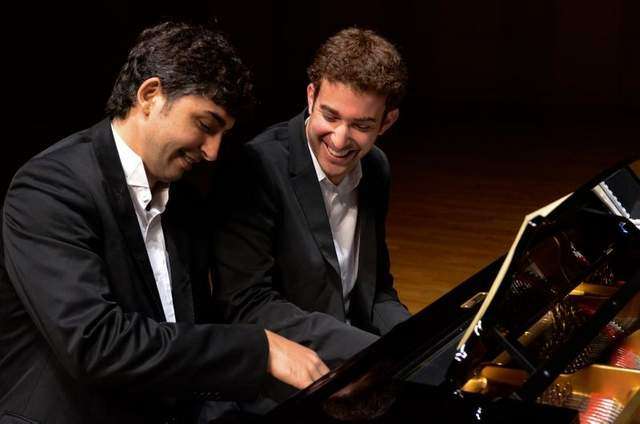|
Back
The Sound of Four Hands Laughing New York
Metropolitan Museum of Art
11/09/2013 -
Ludwig van Beethoven: Symphony No. 7, Opus 92 (Four-hand transcription by Hugo Ulrich)
Avner Dorman: Karsilama
Sameer Odde-Tamini: Amal
Igor Stravinsky: The Rite of Spring (Two-piano transcription by the composer)
Duo Amal: Bishara Haroni, Yaron Kohlberg (Duo-pianists)

B. Horoni, Y. Kohlberg(© www.duo-amal.com)
The Duo Amal can be described in so many ways. A terrific young piano team...the first bi-Semitic musical duo...an example of extreme Philotriskaideka (see below).
Most of all, though, after their dynamic keyboard playing at the Metropolitan Museum of Art last night, they produced an excitement based upon enthusiasm and, yes, an empathy, a lack of ego shown by few young musicians as dynamic as they are.
Bishara Haroni, a Palestinian, and Yaron Kohlberg, an Israeli, met and performed first in Oslo, as a gesture to the peace of their two peoples. Yet so good did they prove to be that they soon overcame their uniqueness. And their odd selections ensured that Duo Amal (amal in Arabic means “hope”) could cross the globe together, both as duo-pianists and with international orchestras. For the scholarly-looking Haroni and the prepschool-looking Kohlberg, work with their own sides of the pianos with an electrifying concordance.
Last night, their choices were part eccentric, part balanced, and even in questionable works, they left left no question about their artistic partnership.
The recital was based first upon a love for the number 13 (thus the neologism above, “philotriskaideka”). Music composed over three centuries in 1813, 1913 and 2013. The balance of the four works included two massive arrangements of orchestral works, and two pieces composed for the group, one from an Israeli and one from a Palestinian composer.
They started, though, with an arrangement of Beethoven’s Seventh. Not by Franz Liszt, but with a straight four-hand transcription by one Hugo Ulrich, a 19th Century German composer. Liszt was a master, but he often fudged his arrangement with tremolos and keyboard flourishes. Mr. Ulrich took his four-handed arrangement and kept it straight. One could almost hear the winds and brass passages but without those literal notes, it was still a true piano-symphony.
This was an initial look at Duo Amal, with Hironi on treble, Kohlberg down below. From the bass, Kohlberg jumped about while Hironi was more sober. Yet both retained what would seem to be impossible, a sense of clarity, of contrapuntal transparency, even in the slow movement. The fugue was played lightly, the sudden sforzandi rebounded. Most important, the rhythms were crisp and danceable.
The second transcription was Stravinsky’s own, of his Rite of Spring. Those who can’t live without that fiery revolutionary orchestration might have been disappointed. For myself, this was even more successful than the Beethoven–for a single reason. To the surprise of many, the piano is a percussion instrument, and the Rite is a violently controlled percussive piece. So it worked.
Working as well were Duo Amal, doing two things at once. First, every fractional difference between the two was accented with quantum force. Second, while they could never “color” this work, the two seemed to actually have fun through all the balletic music, playing their keyboards with honest urgency.
In between these two orchestral works (and a wonderful encore arrangement of Prokofiev’s First Symphony finale by Rikuya Terashima), the two played a pair of works commissioned by a well-known Israeli and a hopefully soon-to-be-well-known Palestinian.
Avner Dovner is a very accomplished composer, but his Karsilama, based on an East Turkish dance, was more a bagatelle, a jeu d’esprit for the two artists. One could easily mistake it for one of Darius Milhaud’s jolly piano pieces, but no less entertaining for all that.
Amal by Sameer Odde-Tamimi used techniques dating back 60 years to Cowell, Bartók and Cage, plucking the inner springs, hold arms across the keyboard etc. Still, he created an interesting sound picture of chaos and peace, a whirling of massive chords, moving against themselves and the placidity of...well, perhaps of amal, hope itself.
Needless to say, Duo Amal played it with their usual energy, and in this rotation of ferocity and tenderness, two emotions which seem to come as natural to them as the naturalness of their wonderful musical partnership.
Harry Rolnick
|